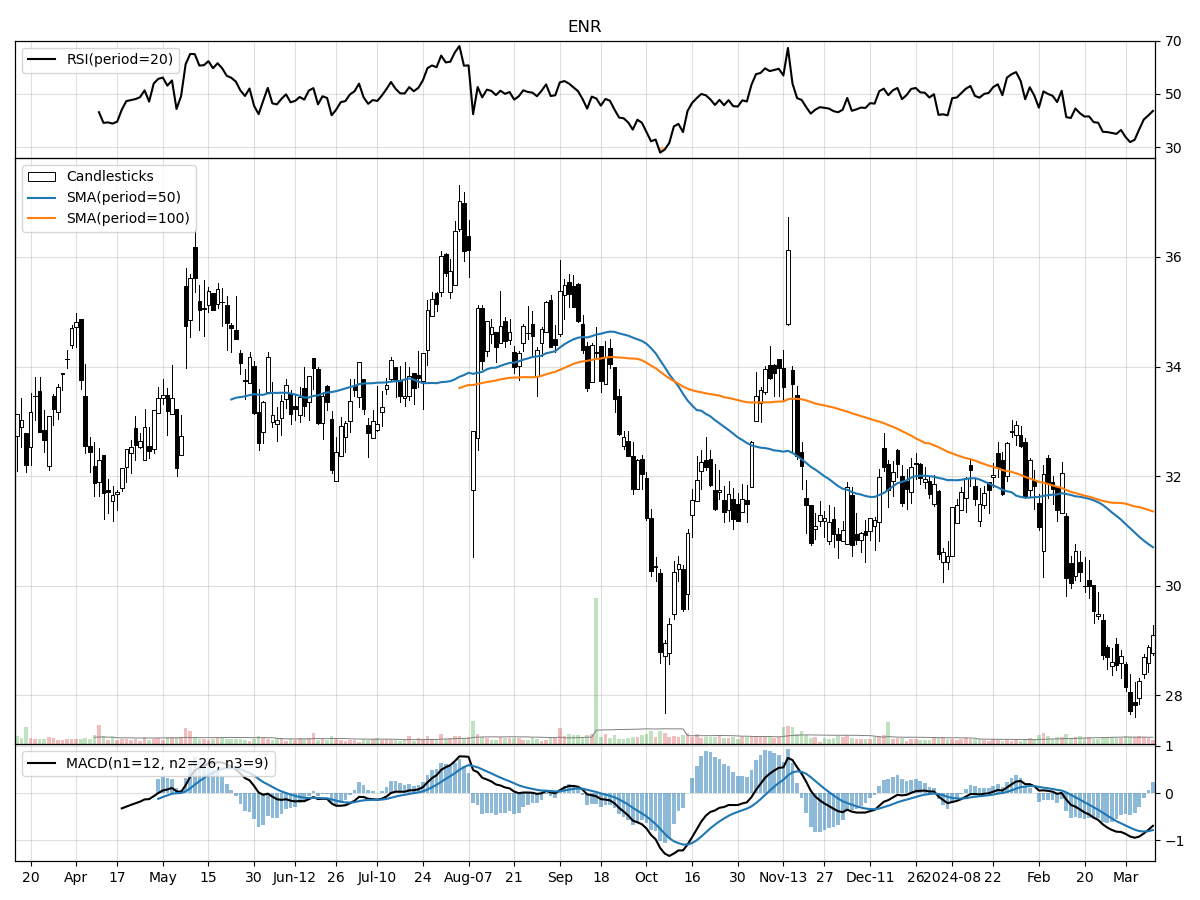Energizer Holdings Inc. (ENR), Mid/Small Cap AI Pick of the Week

March 14, 2024
Weekly AI Pick from the S&P 400 or S&P 600
Company Overview
Energizer Holdings, Inc. is a prominent player in the global market for batteries, auto care, and portable lighting products, with well-established brands like Energizer®, Eveready®, Rayovac®, Armor All®, and STP®. The company distributes its products across various retail channels, including e-commerce, and maintains a competitive edge by holding over 2,800 trademarks and patents to protect its technologies and brands. Energizer's product lineup spans from batteries to automotive fragrances and portable lighting, with sales experiencing seasonal fluctuations—battery sales peak in the first fiscal quarter, while automotive products sell more in the second and third quarters, with spikes also occurring due to natural disasters.
Energizer's culture is built on teamwork, bold action, and integrity, with a commitment to diversity, equity, inclusion, and employee career development among its 5,080 global employees. The company places a high priority on workplace safety, requiring annual retraining on global safety policies, and aligns its operations with safety standards such as ANSI Z-10 and ISO 45001. Furthermore, Energizer is dedicated to community support through initiatives like the Energizer Giving Foundation and advocacy for hearing health. However, Energizer must navigate various regulations related to consumer safety, environmental protection, competition laws, and data protection, such as GDPR and CCPA. The company acknowledges potential risks from environmental liabilities and makes its policies and regulatory reports available to the public on its official website and the SEC website.
By the Numbers
Annual 10-K Report Summary:
- Net earnings for fiscal year 2023: $140.5 million (compared to a net loss of $231.5 million in the previous year).
- Net sales for fiscal year ended September 30, 2023: $2,959.7 million (a decrease of 3.0% from the previous year).
- Gross profit margin for fiscal year 2023: 38.0% (improved from the previous year).
- SG&A expenses as a percentage of net sales: Increased slightly year-over-year.
- A&P costs: Increased from the previous year.
- R&D expenses: Decreased marginally from the previous year.
- Amortization expenses: Decreased due to the full amortization of certain intangibles.
- Interest expenses: Increased due to higher interest rates.
- Other net expenses: Significant rise, largely due to a pension settlement loss.
- Costs related to the exit from the Russian market and Brazilian facility flood: $9.7 million.
- Project Momentum annual pre-tax savings fully realized as of September 30, 2022.
Quarterly 10-Q Report Summary:
- Net earnings for the quarter ended December 31, 2023: $1.9 million (compared to $49.0 million in the previous year's quarter).
- Adjusted net earnings for the quarter: $42.5 million (down from $51.8 million year-over-year).
- Net sales for the quarter: $716.6 million (a decrease of 6.3% year-over-year).
- Reported Gross Margin for the quarter: 37.3% (down from 39.0% in the previous year's quarter).
- Adjusted Gross Margin for the quarter: Improved slightly due to cost savings.
- Segment profit for Batteries & Lights: Decreased by 4.3%.
- Segment profit for Auto Care: Decreased by 34.9%.
- General corporate expenses: Increased by $3.8 million, mainly due to compensation costs.
- Cash flow from operations for the quarter: Improved to $178.1 million (up from $161 million).
- Capital expenditures projected for fiscal 2024: Between $95 to $105 million.
- Long-term debt: $3.296 billion.
- Mandatory transition tax: $16.7 million.
- Future purchase commitments over the next five years: $7.4 million.
- Payments for operating leases at the end of 2023: $142.7 million.
- Payments for financing leases at the end of 2023: $92.7 million.
- Environmental obligations: $14.7 million.
(Note: The financial figures provided are typically reported in thousands or millions of U.S. dollars in such reports, but the unit scale for net earnings, losses, and savings is not specified in the provided summaries and should be confirmed for accurate financial analysis.)
Stock Performance and Technical Analysis

Based on the provided technical data, the stock is currently trading at $29.10, which is a modest 4% above its 52-week low, indicating limited downside risk but also suggesting a lack of strong upward momentum in the near term. Being 21% below its 52-week high conveys that the stock has experienced a significant pullback from its peak price levels, potentially offering a discounted entry point if the long-term fundamentals of the company remain solid. However, investors should be cautious as this could also signal a change in the market's perception of the company's value or growth prospects.
The recent daily trading volume is slightly below the longer-term average, which may indicate a decrease in trader interest or conviction, possibly leading to lower liquidity and higher volatility. The stock's price has been relatively stable over the last month, yet it has fallen by about 9.54% over the last three months, which could be seen as a negative trend, potentially reinforcing the bearish sentiment around the stock.
The Money Flow indicators, which assess the buying and selling pressure on a stock, suggest that the stock is experiencing moderate selling pressure and is under distribution, meaning that more investors could be selling their shares than buying. This is often a bearish signal, implying that the stock might continue to face downward pressure in the short term. Additionally, the Moving Average Convergence Divergence (MACD) is bearish at -0.78, indicating that the short-term momentum is weaker than the long-term momentum, and this could be interpreted as a sell signal by traders.
In summary, the technical analysis points to a bearish sentiment for the stock at this point in time. The combination of being significantly off its highs, under moderate selling pressure, and bearish MACD values suggest that investors should proceed with caution. If considering an investment, one should closely examine the company's fundamentals, including its financial health, competitive position, and growth prospects, alongside these technical indicators to make a more informed decision. Investors could also wait for technical indicators to show signs of a reversal before entering a position to capitalize on potential upward momentum.

The ‘Bull’ Perspective
Energizer Holdings, Inc. (ENR): A Power-Packed Investment Opportunity
Upfront Summary:
- Robust Cash Flow Generation: Energizer's cash flow from operations improved to $178.1 million, underscoring the company's efficiency in managing its working capital and maintaining solid liquidity.
- Strategic Cost Savings: Project Momentum is on track to deliver substantial pre-tax savings, with $76 million already realized, aiming to enhance profitability by fiscal year 2025.
- Debt Management: Energizer's proactive debt management, including a $75 million prepayment of its Term Loan, reflects a strong commitment to financial health and long-term stability.
- Market Position and Brand Strength: Despite competitive pressures, Energizer's leading market position and strong brand portfolio continue to drive consumer loyalty and support pricing power.
- Attractive Valuation: The stock's current market valuation, when juxtaposed with its peers and historical metrics, presents a potential upside for investors considering long-term growth and stability.
Elaborating on the Investment Case:
- Robust Cash Flow Generation:
Energizer's cash flow from operations, which has seen a notable increase to $178.1 million, is a testament to the company's ability to convert earnings into cash effectively. This is not just a one-off event but a consistent pattern that demonstrates Energizer's operational efficiency. The improved cash flow provides the company with the necessary capital to invest in growth initiatives, manage debt, and return value to shareholders. In the context of the recent economic headwinds, this robust cash flow positions the company well to weather potential market volatility and maintain its operations without strain. - Strategic Cost Savings:
The company's strategic initiative, Project Momentum, is a cornerstone in its cost-saving efforts, with a target to achieve significant pre-tax savings by fiscal year 2025. Already, $76 million in savings have been realized, which is a clear indicator of the project's success and the company's commitment to operational excellence. These savings are critical in offsetting inflationary pressures and maintaining competitive margins, particularly in a challenging economic environment where cost efficiency is paramount. - Debt Management:
Energizer's proactive approach to debt management, highlighted by the $75 million prepayment of its Term Loan, is a strong indicator of fiscal prudence. This move not only reduces interest expenses but also demonstrates the company's ability to generate sufficient cash flow to manage and reduce its debt obligations. In a market where high debt levels are a concern for many companies, Energizer's focus on maintaining a healthy balance sheet is reassuring for investors and may provide a buffer against interest rate fluctuations and economic downturns. - Market Position and Brand Strength:
Despite the competitive landscape, Energizer's market position remains robust, supported by its portfolio of well-recognized brands. The company's brand equity translates into consumer loyalty, which is critical in driving sales and enabling pricing strategies that can mitigate the impact of rising costs. Energizer's strong brand presence, especially in the battery segment, ensures that it remains a go-to choice for consumers, which is vital for sustaining revenue streams even when market conditions are challenging. - Attractive Valuation:
Looking at the stock's valuation metrics, Energizer presents an attractive investment opportunity. The stock is trading at a discount relative to its historical averages and peers, with a potential for price appreciation as market conditions stabilize and the company's strategic initiatives bear fruit. The combination of Energizer's solid cash flow, cost-saving measures, debt management, and strong market position suggests that the current market price may not fully reflect the underlying value and future growth prospects of the company.
In conclusion, Energizer Holdings, Inc. stands out as a compelling investment opportunity for those seeking a blend of stability, growth potential, and proactive management. The company's ability to generate strong cash flows, its strategic cost-saving initiatives, prudent debt management, enduring market position, and attractive valuation make a strong case for its inclusion in a well-diversified investment portfolio. While risks such as economic disruptions and competitive pressures exist, Energizer's strengths and strategic responses position it well to navigate these challenges and offer investors potential upside in the long run.

The ‘Bear’ Perspective
Title: The Case Against Investing in Energizer Holdings, Inc. (ENR): A Bearish Perspective
Upfront Summary:
- Declining Financial Performance: Energizer's recent quarterly net earnings plummeted to $1.9 million from $49.0 million the previous year, with net sales decreasing by 6.3% to $716.6 million.
- Challenging Market Conditions: The company faces stiff competition, a shift to devices with built-in batteries, and potential supply chain disruptions that could further squeeze margins and market share.
- Operational Risks and Cost Pressures: Rising production costs, reliance on key suppliers, and the need for continuous innovation amidst a competitive landscape present significant operational challenges.
- Geopolitical and Economic Uncertainties: Global economic conditions, including inflation and geopolitical tensions, particularly the situation in Ukraine, could adversely impact consumer spending and Energizer's international operations.
- Debt and Financial Obligations: A significant debt load of $3.296 billion and long-term financial commitments may constrain the company's financial flexibility and responsiveness to market changes.
Elaboration on Points:
1. Declining Financial Performance:
Energizer's latest financial results are a red flag for potential investors. The stark decline in net earnings to just $1.9 million, down from $49.0 million in the prior year, is indicative of underlying issues that could be symptomatic of deeper problems within the company. Net sales also took a hit, dropping by 6.3% to $716.6 million, signaling a concerning trend in consumer demand and operational efficiency. With a reported gross margin decrease from 39.0% to 37.3%, the company's ability to convert sales into profit is diminishing, which could spell trouble for future financial stability.
2. Challenging Market Conditions:
Energizer is not operating in a vacuum; it faces fierce competition from other battery and consumer goods manufacturers. The shift towards devices with integrated, non-removable batteries is a consumer trend that cannot be ignored, and it directly threatens the core battery business of Energizer. Additionally, the company's reliance on a few key retail customers for a large portion of sales introduces a high level of risk should these retailers shift their strategies or face their own downturns. These market conditions create an environment where Energizer's market share and margins are under constant threat.
3. Operational Risks and Cost Pressures:
The operational risks facing Energizer are multifaceted. Rising production costs, which may not be fully offset by price increases due to competitive market pressures, could lead to margin contraction. The company's dependence on a limited number of suppliers for essential materials adds to the risk profile, as any supply chain disruptions could have immediate and adverse effects on production and sales. Furthermore, Energizer's need to invest heavily in innovation to keep up with rapidly changing consumer preferences and technology advancements is a constant pressure on the company's resources.
4. Geopolitical and Economic Uncertainties:
Energizer's global operations expose it to various geopolitical and economic risks. The recent economic reforms and currency devaluation in Argentina have already foreshadowed potential reductions in operating profit. Geopolitical tensions, such as the ongoing conflict in Ukraine, could further destabilize global markets, affecting consumer spending and international operations. In an environment where inflation is a growing concern, Energizer's international sales and earnings could be negatively impacted by fluctuating exchange rates and changes in fiscal policies.
5. Debt and Financial Obligations:
The company's financial obligations are a looming concern. With long-term debt amounting to $3.296 billion, Energizer's ability to maneuver financially is significantly constrained. The servicing of this debt, along with other financial commitments, could limit the company's ability to invest in growth opportunities or respond effectively to market downturns. The need to secure additional financing in a volatile market could result in unfavorable borrowing terms or dilution of shareholder value, further exacerbating the financial challenges faced by the company.
In conclusion, while Energizer Holdings, Inc. may have a recognizable brand and a history of performance, the current financial, operational, and market risks present significant challenges that cannot be overlooked. The combination of declining financial performance, competitive market pressures, operational risks, geopolitical uncertainties, and a heavy debt burden make a compelling case for investors to exercise caution and consider alternatives when looking to add to their investment portfolios.

Comments ()